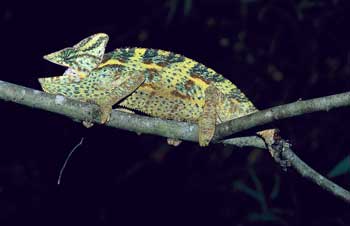The guy at the reptile show said that if I handled my chameleon enough he would not bite when he was older. Is this true?
My juvenile veiled chameleon has been acting strangely for the past two weeks. I purchased him when he was about 3 inches long, not including the tail. The guy at the reptile show said that if I handled him enough he would not bite when he was older. I took this to heart and started handling him once every day for about 15 minutes. I purchased him in August and he is now about 4 1/2 inches long.
My chameleon seemed to enjoy his daily handling until recently when I reached in and tried to take him out of his enclosure. He puffed himself up and tried to bite me. I thought that he might be shedding, so I waited for him to show signs that he was going to shed but nothing happened. I then checked the Internet, and discovered that I shouldn’t be handling him and that doing so causes stress.
Should I believe the reptile show guy or the Internet? Do you have any suggestions on what I could do to make my chameleon stop biting whenever I try to handle him?
Bethany Baird
Idaho Falls, Idaho
 Veiled chameleons will bite in defense if they feel threatened. This wild specimen assumes the approaching photographer might be the same predator that recently severed its tail. |
No chameleon enjoys being handled by people. Whoever told you that was throwing you a deceptive sales pitch to convince you to buy a pet from him. Chameleons should only be considered as pets on par with tropical fish – great to behold, but not intended to be actually touched or held.
For shy creatures, as all true chameleons essentially are, contact with a larger creature is the normal precursor to being eaten or crushed to death – the ultimate stress! It signifies immediate danger and often triggers the best avoidance response the lizard can mount. Because rapid flight is not an option, biting is a last-ditch defense to stave off what they expect is approaching doom. That reaction has evolved over hundreds of thousands of years to help chameleons survive in the wild. Think of it as hundreds of thousands of successive generations honing a behavior until it’s become instinctive in nature. A few generations in captivity are not enough to erase all that inherited learning.
Your Chamaeleo calyptratus may be captive bred, but that shouldn’t tempt you to assume it’s automatically lost all its natural instincts. It will probably continue to behave erratically, often being calm and seemingly tame, then surprising you with inexplicable periods when its tolerance for the proximity of people has totally evaporated. Its mood du jour may depend on factors, such as breeding season stimuli (like temperature and/or photoperiod), as it matures, or simple disturbances like the family cat having sat by its cage for an hour before you walked into the room.
My suggestion on how to deal with your lizard’s bad moods: Cease handling activities for at least a few hours, if not days, and see if its attitude changes next time. If for some reason you must engage in some hands-on activity, keep it as loosely restrained as possible. Carrying the perch the chameleon is clinging to, instead of actually grasping its struggling body, would be an example of a less stressful method of handling it.


